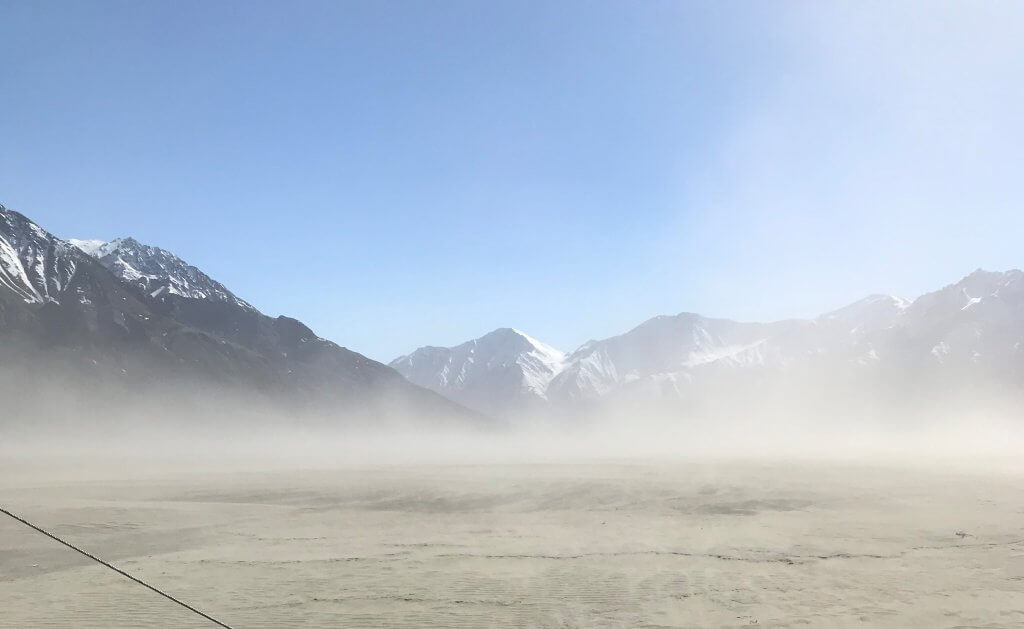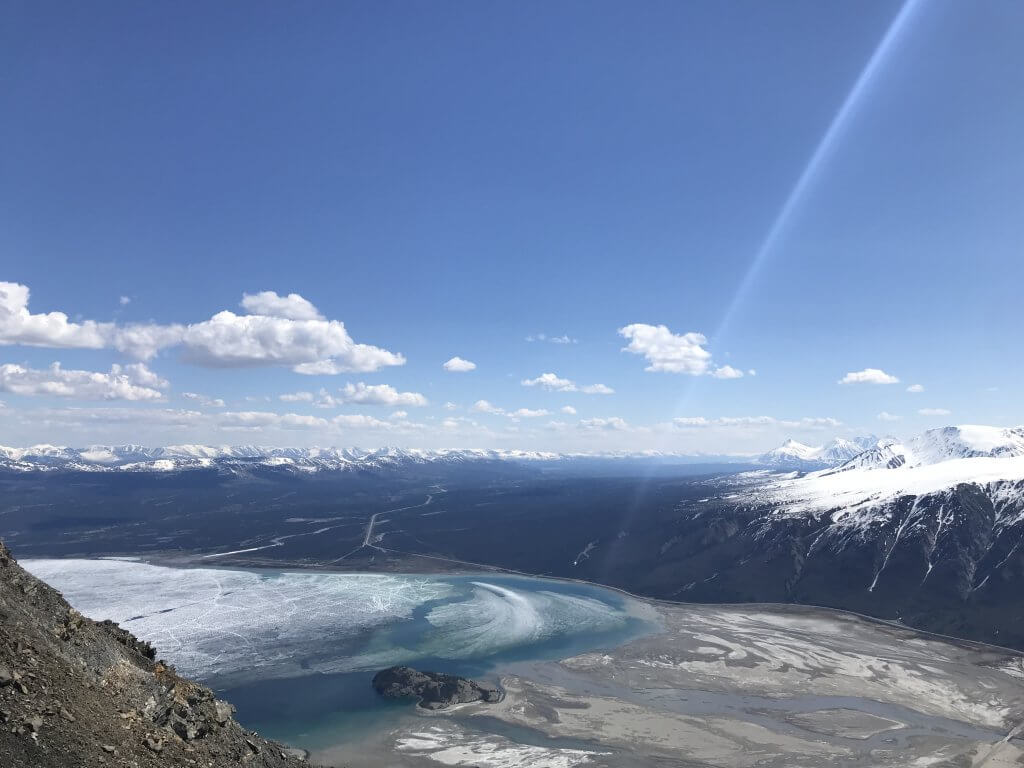
An overview of field work conducted on high-latitude mineral dust aerosol in the Ä’äy Chù Valley in Kluane National Park, Yukon
– By Arnold Downey –
Mineral Dust Aerosol (MDA) is known to have an important influence on several environmental topics. Like all aerosol, MDA plays a role in the radiative balance of the atmosphere, as it scatters and absorbs solar and terrestrial radiation. It also has a secondary effect on radiative forcing, as it acts as cloud condensation and ice nuclei. <!–more–> With estimated global yearly dust fluxes being on the order of petagrams (trillions of kilograms), the impact it has on climate as an atmospheric constituent cannot be overlooked. MDA also influences local air quality. Dust storms may introduce concentrations of particulate matter to regions that exceed regulatory health limits. The World Health Organization (WHO) places 24-hour guidelines for PM2.5 concentrations (that is, the concentration of particulate matter with a diameter of less than 2.5 µm) at 15 µg/m3, while that for PM10 is 45 µg/m3. MDA affects atmospheric visibility, and its transport is part of the geochemical cycling of nutrients important for biogeochemistry, among other notable environmental effects.

With the barrage of roles that MDA plays in the environment, an understanding of its chemical and physical properties across the globe serves as valuable information to scientists across many disciplines. Although a substantial amount of research is committed to MDA as a whole, little is known about high-latitude MDA specifically. There are many reasons for this. Performing dust studies, or any study in high latitudes, is logistically difficult with population density and the resources of urban centers dropping off rapidly as one moves north of the 49th parallel. Northern environmental conditions can be harsh also, in terms of meteorology, wildlife, and natural hazards. High latitudes are nonetheless a significant source of MDA and with high latitudes experiencing some of the most pronounced effects of climate change, the conditions for dust emissions could possibly change as well. It is for this reason that the Patrick Hayes’ group at the University of Montreal holds high-latitude MDA as one of their core research topics. The group has spent many of the recent late springs/early summers conducting field campaigns centered around the Ä’äy Chù Valley in Kluane National Park, Yukon, located north of the Kaskawulsh Glacier. This region is an important case study for understanding the impacts of climate change. The recession of the Kaskawulsh Glacier over the past decades has caused the Ä’äy Chù River to reroute, converting the former river to a much drier valley and replacing the river with a surface of sediment. This sediment is subject to strong glacial winds and a subarctic climate punctuated by dry, cool summers in the Kluane region. These conditions are ideal for dust storms, and so more frequent and severe dust events have been observed.

As mentioned above, another important impact that the dust has is on the radiative forcing of the atmosphere. MDA tends to have a cooling effect on the climate, as it primarily scatters atmospheric radiation and has been reported to cause globally a decrease of the net surface radiative forcing of about 1 W/m2. Although, MDA possesses a small, but measurable, imaginary refractive index, indicating that it also absorbs radiation, unlike some other types of aerosols like sea salt (NaCl) and sand (SiO2) that have no imaginary refractive index component. The 2022 Kluane campaign was focused on directly measuring the optical propertied of the MDA by means of Photoacoustic Extinctiometer (PAX) instruments. PAX instruments can measure the scattering coefficient and the absorption coefficient of aerosol particles in real time, using the collection of scattered laser light by a detector for the scattering coefficient determination, and a sensitive microphone to detect sound waves produced by the aerosol when it is heated from absorbing the same laser beam. This data is currently being processed with the goal of assessing the optical properties of the MDA directly, as well as relating these properties to the dust composition.

Regarding air quality, results from the 2019 Kluane campaign conducted by Jill Bachelder of the Hayes Group showed that WHO air quality guidelines were indeed surpassed as a result of the elevated dust activity in the Ä’äy Chù Valley. 24-hour PM10 concentrations above 1000 µg/m3 and PM2.5 concentrations above 250 µg/m3 were recorded in the Ä’äy Chù Valley and near Kluane Lake. PM10 and PM2.5 guidelines were also surpassed several times at the Parks Canada Visitor’s Center for the Ä’äy Chù Valley. A study like this serves as an important basis for considering the effect that climate change is expected to have due to increased mineral dust activity. While this study did assess the concentrations of various metals of interest to human health in the dust, including lead and arsenic, the bio-accessibility of these metals from the dust was not assessed. This is one of the next steps to be taken for this project to further our understanding of the air quality impact. To accomplish this, an inhalation-ingestion bioassay method developed by Dr. Farzana Kastury at the University of South Australia will be implemented on MDA samples collected during the 2021 Kluane campaign. This method is designed to provide a conservative estimate of the bio-accessibility of metals and metalloids in PM10 to the pulmonary and gastro-intestinal system. Involving the gastro-intestinal system is an important factor to consider, as a most PM10 inhaled is transported to the gastro-intestinal track after about 24 hours in the lungs.
Understanding the implications that the evolving dust emissions have in the Kluane region is especially important for assessing the impact that climate-driven environmental changes will have on populations that inhabit the region. The Kluane Lake area is home to Kluane First Nation and is the traditional territory of the Lù’àn Män Ku Dän, (which means Kluane Lake People in the Southern Tutchone language). Their traditional territory stretches in all directions from Łù’àn Mǟn (Kluane Lake) to the Ruby and Nisling mountain ranges to the northeast and the St. Elias Mountains to the southwest. The region is shared also by two other first nations; the Champagne Aishihik and the White River First Nation.
High-latitude MDA, specifically in the Kluane region, is endlessly intriguing from an atmospheric chemistry perspective. The Hayes Group is privileged to conduct this research while being able to see and explore such a beautiful part of the world. As researchers, we hold a deep appreciation for Kluane First Nation as well as the other First Nations in the Yukon, the original stewards and occupants of the land, which permit the realization of projects such as these. The Hayes Group would also like to acknowledge the massive contributions from Professor James King and his research group in the Geography Department at the University of Montreal, as this work would not be possible without this collaboration. The Hayes Group would also like to acknowledge the financial contributions of the major sponsors on the project, The Canadian Mountain Network, Polar Knowledge Canada, and the Natural Sciences and Engineering Research Council (NSERC).

Arnold Downey is a doctoral student at the University of Montreal (UdeM) under the supervision of Professor Patrick Hayes. Arnold obtained his Bachelor of Science degree with a major in Chemistry and a minor in Atmospheric Science from McGill University in 2018. Before beginning a master’s degree at UdeM that would be fast-tracked into a doctoral program, he spent time gaining experience while working in industry, working as an analytical chemist at AGAT Laboratories in Montreal, Quebec and Canadian Nuclear Laboratories in Chalk River, Ontario.
Questions concerning the article or research by the Hayes group in general can be sent directly to the author at arnold.downey@umontreal.ca.
Ä’äy Chù Valley, arnold downey, kluane national park, mineral dust aerosol, yukon
